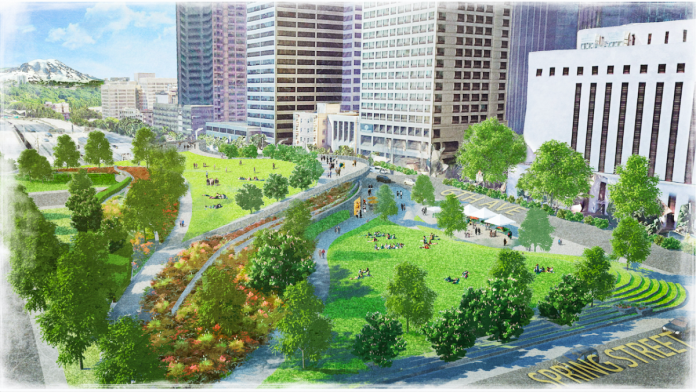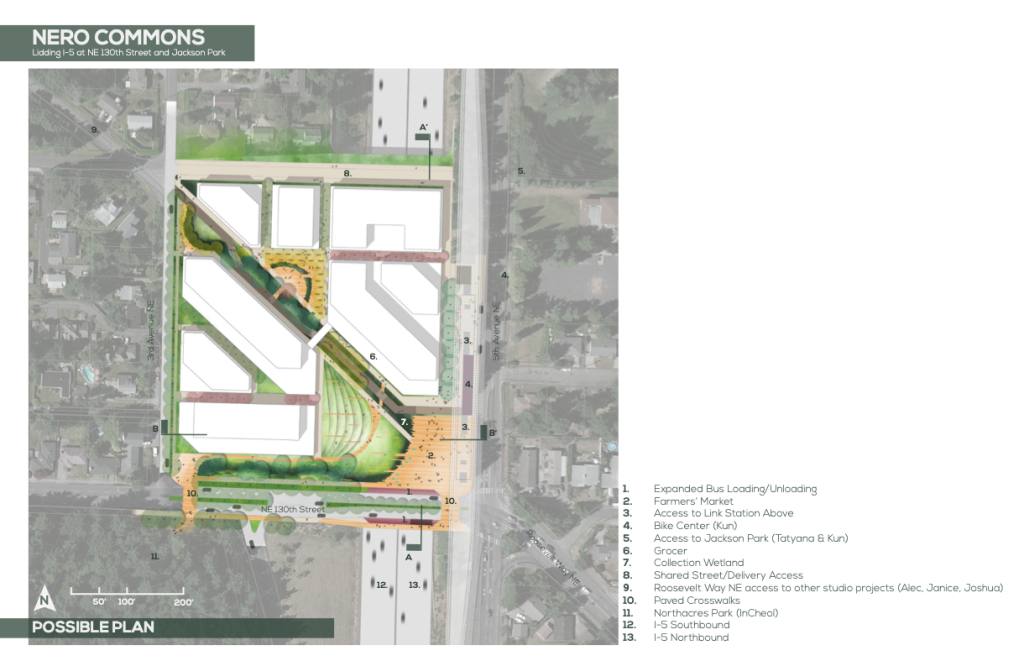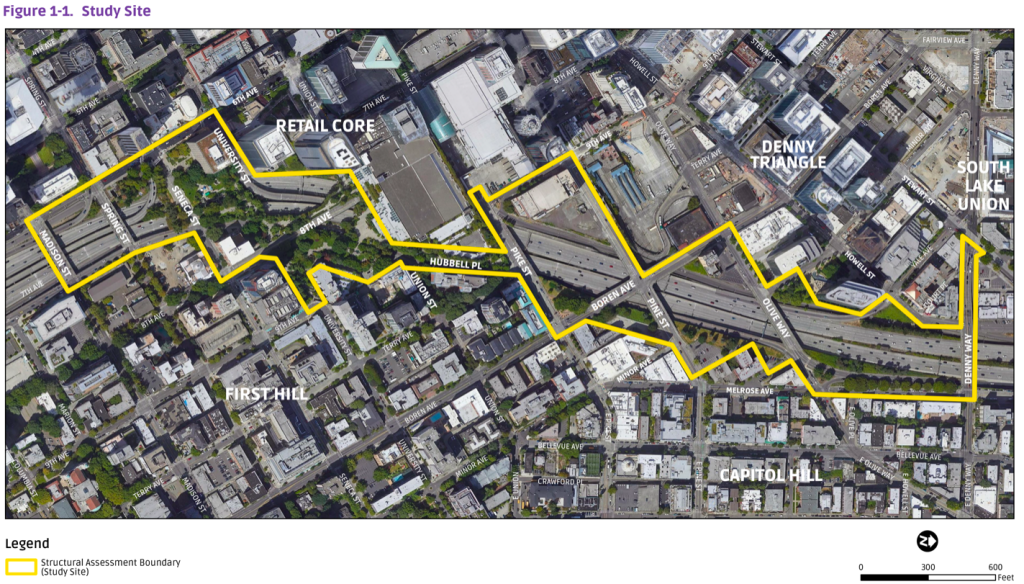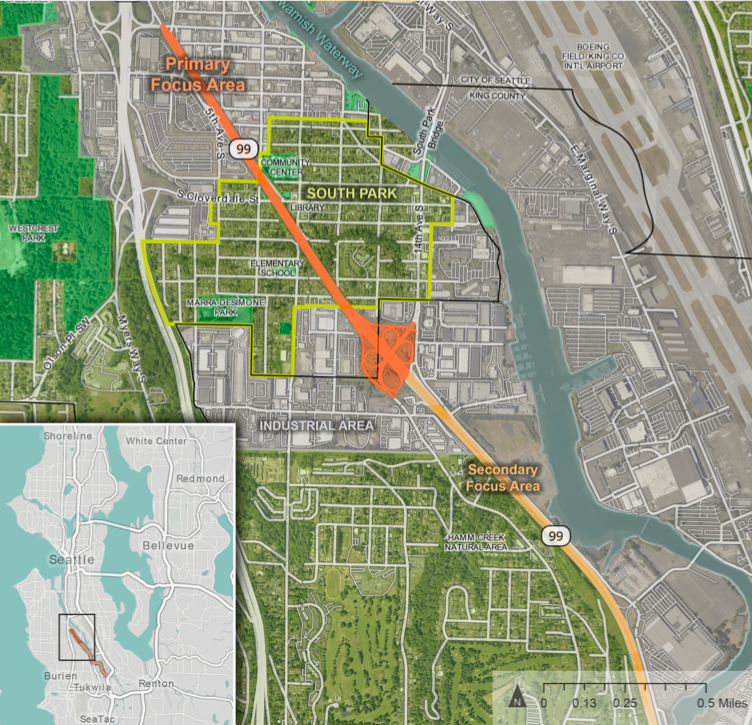
At the junction of SR 520 and Montlake Boulevard in Seattle, construction crews are busy at work laying the foundation for the Montlake lid, the first roof built over a freeway in Seattle since the completion of the I-90 lid in the 1990s. When completed, the Montlake lid will bring new pedestrian and bicyclist connections, a neighborhood plaza with open space, and improved transit stops to a corner of Seattle long bifurcated by the SR 520 freeway canyon.
While the Montlake lid, and the accompanying Roanoke lid, are currently the only freeway covering projects in the works in Seattle, that might change in the near future. Support for building connections across freeways has been gaining in momentum, including among members of the Seattle City Council. On December 8, the land use committee unanimously approved two amendments to Seattle’s Comprehensive Plan asserting its support for using lids and other connections over highways and interstates to reconnect divided neighborhoods. The amendments will go before the full City Council for a final approval vote on December 13.
By providing a framework for how Seattle will grow in the next 20 years, the Comprehensive Plan creates a big picture vision for what Seattle’s future will be. Including freeway lids as part of that vision means that this infrastructure can be considered, and even prioritized, in future city planning decisions around land use, transportation, and parks.
Language in support of freeway lids already exists in Seattle’s Comprehensive Plan, but the two new amendments, one to growth strategy and another to transportation strategy, provide specificity around the opportunities lids open up for the creation of affordable housing, open space, and safe connections for people walking and biking, especially near transit stops.
The importance of using lids to connect people to transit was emphasized by Councilmember Dan Strauss (District 6), whose remarks highlighted the benefits a potential lid would bring to the area near the future 130th Street Sound Transit Link light rail station, scheduled to open in 2026.
Safe access to the 130th Street Station has arisen as a point of concern for the Seattle Department of Transportation (SDOT) since 90% of future light rail riders are expected to arrive at the station by walking or rolling.
While SDOT is exploring widening the existing narrow sidewalk on the I-5 overpass among other improvements, construction of a lid would open up new possibilities for sidewalks, trails, and even transit oriented development (TOD). As part of a University of Washington graduate school project, Derek Holmer, a current urban designer at King County Metro, illustrated these possibilities in a design vision for a 130th Street lid called the Nero Commons.

According to Strauss, however, the benefits of lidding the freeway should not be limited to 130th Street.
“This could be mirrored time and time again through out the corridor. We should lid as much of the city as possible,” Strauss said.
Katy Ricchiuto, Urban Vitality Manager for the U District Partnership, also hopes that freeway lids will have a future throughout Seattle’s interstate corridor.
“Like many neighborhoods in the city, communities in north Seattle like the U District, Roosevelt, and Wallingford have been bifurcated by I-5 for decades. The new comprehensive plan amendments and major federal and state investments in I-5 mean the time is right to reclaim space over the highway,” Ricchiuto said in a written statement.
In agreement is Scott Bonjukian, co-chair of the Lid I-5 campaign’s steering committee and an urban planner and designer with MAKERS (Bonjukian is also a former boardmember with The Urbanist). Since it succeeded in securing funding for a study that demonstrated the technical feasibility of lidding I-5 in Downtown Seattle, the Lid I-5 campaign has been engaged in drumming up local and state for support for freeway lids. (Note: the author is a member of the Lid I-5 steering committee.)
In conversation with The Urbanist after the land use committee meeting, Bonjukian was positive about the advancement of the two Comprehensive Plan amendments, but he was also quick to point out that the future of lidding freeways in Seattle rests more heavily on Seattle’s Comprehensive Plan Major Update, which will be adopted next year.
During that process, Bonjukian hopes that all current lid policies will be retained and that the City will “double down” on its support for more options for freeway lids in the plan.

All in all, the significant increase in recent years to awareness and excitement around freeway lids has not been lost on Bonjukian.
“I think [lidding] is more in the public consciousness, so our role now is to channel that energy in the most productive direction we can,” he said.
For the Lid I-5 campaign, that means pursuing funding from the new federal grant programs such as Reconnecting Communities and Neighborhood Access and Equity in partnership with the City of Seattle or likeminded nonprofit organizations. Such funding would be used to advance the work already accomplished by the technical feasibility study and move Seattle closer toward making the Downtown study area lid a reality.
Financial support from the Washington State Legislature for lidding or building connections across freeways has already made its way to Seattle. This year Reconnect South Park was awarded $600,000 to study the removal or restructuring of SR 99 through South Park, which has only one street level crossing and one pedestrian overpass connecting people across the highway throughout the entire neighborhood.

With communities across Seattle negatively impacted by the presence of state highways and federal interstates, numerous possibilities for reconnection exist. Freeway lid concepts have already been studied by landscape architecture and urban planning students in the University District and SoDo.
Across Lake Washington in Bellevue, a freeway lid park over I-405 has been incorporated into the Grand Connection project proposal, which seeks to create new vibrant public spaces and improve the pedestrian experience across a 1.5 mile stretch of Downtown Bellevue. Recently Amazon donated $2.5 million to the City of Bellevue to support the lid park and other Grand Connection elements.
Readers interested in learning more, and supporting the advancement of freeway lids, can sign up for the Lid I-5 campaign newsletter. The author is a member of the Lid I-5 steering committee.
Natalie Bicknell Argerious (she/her) is a reporter and podcast host at The Urbanist. She previously served as managing editor. A passionate urban explorer since childhood, she loves learning how to make cities more inclusive, vibrant, and environmentally resilient. You can often find her wandering around Seattle's Central District and Capitol Hill with her dogs and cat. Email her at natalie [at] theurbanist [dot] org.

